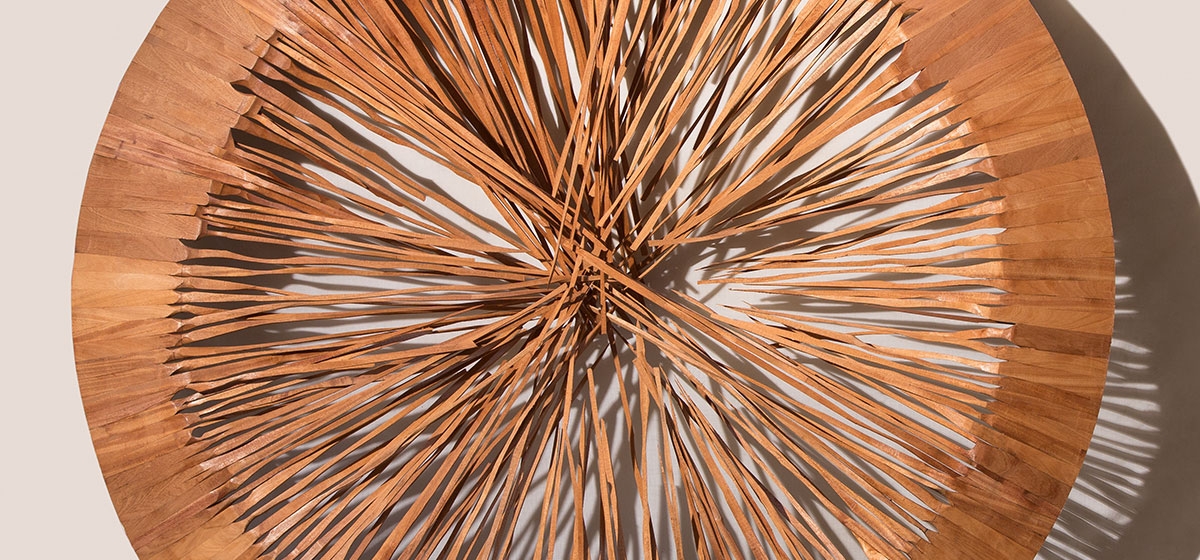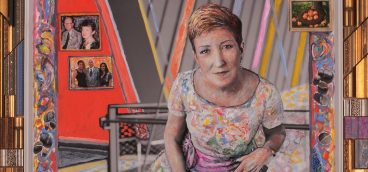Exploring the Work of Damianos and Mulcahy at the Westmoreland

To paraphrase a new friend, director general of the Pakistan National Council of the Arts Jamal Shah: in celebrating life, art follows the inquisitive human mind in its desire to delve deeper as it challenges the established reality and surprises us with new realities. It challenges us to deepen our quest to explore the overwhelming realm of the unknown.
[ngg src=”galleries” ids=”172″ display=”basic_thumbnail” thumbnail_crop=”0″]
What a perfect description of the work of both Kathleen Mulcahy and Syl Damianos now on view at the Westmoreland Museum of American Art. Opposites Attract (November 5 – February 5), installed in the new and spacious cantilevered gallery at the museum, is actually two one-person shows, offering an in-depth look at each artist’s body of work without being forced to figure out why they are being shown together. The proximity of their work, however, provides an opportunity to find connections between the two that wouldn’t otherwise be evident. The unknown, or the unknowns, challenge us to seek knowledge beyond our usual understandings and our daily life. Looking into it is rewarding, and both artists seek to create works that encourage us to slow down, to escape our minds, and just be in the presence of beautiful and meaningful objects.
Both Damianos and Mulcahy take great care with the process of making their work; both engage with fleeting moments in nature; and both are influenced by the after effects of minimalism. The importance of and attention to craftsmanship and technique is immediately apparent in their work. Damianos “listens” to the wood he finds, pieces that sometimes sit in his studio for years before he figures out what he wants to do with them. Mulcahy defies the limitations of glass, taking it into the realm of sculpture. Damianos’s large wheel is an intricate puzzle purposefully constructed that seems to both celebrate and defy the natural properties of wood, while Mulcahy’s attenuated drops of water seem stretched to the point of no return as they float in front of a nuanced field. Admiring these details provides an easy entrance into the work.
A longer look—think of those people who sit in front of a work of art and quietly look at it for an extended time—rewards with surprises and sensory awakenings. Both artists are inspired by nature. They replicate their experiences in nature in their work, hoping to encourage the viewer to share similar experiences. For Damianos, it is the way light moves across surfaces, whether it be the light filtering through trees or the reflections caused by clouds and sunshine on a window pane. Mulcahy senses the changing atmospheric conditions as storms approach, experiencing an altered state when the mind is taken over by the forces of nature.
In a recent novel, Benjamin Black, the alias for John Banville, wrote about “absence seizures,” those moments when reality fails to control our world and we essentially lose our minds but in a positive way. Neither artist recreates their experience with recognizable details; instead they try to capture the immediacy of their feelings. It is like walking at the beach when the sound of the waves takes over, obliterating the banal details of a quotidian life. The same loss of ego can be experienced when looking at a work of art as a viewer concentrates on some detail or the feeling evoked by the work. This parallel between looking at art and experiencing nature is at the heart of the work in this show.
Both artists intuit and then suggest moments in nature when we lose ourselves in the experience. While not exactly recreating a specific experience, their work invites the same kind of contemplation. Their works are quietly assertive, allowing the eye to wander slowly throughout each piece. Damianos creates minimalistic compositions, fascinated by the arrangement of geometric shapes. He has always been inspired by working with the characteristics of particular materials, from his earlier cast pieces through the grid-based wall pieces to the flowing arrangements of fragments. Mathematical formulas underlie several arrangements, reflecting his fascination with the golden ratio and the Fibonacci sequence.
Mulcahy has been working outside the typical arena of colored glass, limiting her resources to make almost monochromatic works. The backgrounds of these works seemed brushed, like surfaces in minimal works or Asian brushed paintings. The rounded balls or elongated drops, the cubes and the flowers suspended in front of the lush surfaces, animate them in a rhythmic sequence.
Both artists use the simplest of means, a reference to minimalism, to achieve these effects, allowing the viewer to get lost in the works, in the moment, encouraging a slow and quiet read. They, in effect, set the stage for the viewer to enter a liminal space, an in-between place where normal expectations and realities melt away, allowing a new consciousness. The moments when everything slows down and time becomes inconsequential connect the experience of art and the experience of nature. These moments, few and far between, encourage us to enter the unknown for new sensory experiences. These altered states, both experienced and evoked by both artists, is what connects these two very different artists as opposites attract and engage.
Syl Damianos is also an architect who has been active in the Associated Artists of Pittsburgh, AIA, and the Friends of Pittsburgh Art while Kathleen Mulcahy taught at CMU and was the founding director, along with her husband Ron Desmett, of the Pittsburgh Glass Center.





